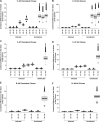HIV infected CD4+ T cell clones are more stable than uninfected clones during long-term antiretroviral therapy
- PMID: 36044447
- PMCID: PMC9432747
- DOI: 10.1371/journal.ppat.1010726
HIV infected CD4+ T cell clones are more stable than uninfected clones during long-term antiretroviral therapy
Abstract
Although combination antiretroviral therapy (ART) blocks HIV replication, it is not curative because infected CD4+ T cells that carry intact, infectious proviruses persist. Understanding the behavior of clones of infected T cells is important for understanding the stability of the reservoir; however, the stabilities of clones of infected T cells in persons on long-term ART are not well defined. We determined the relative stabilities of clones of infected and uninfected CD4+ T cells over time intervals of one to four years in three individuals who had been on ART for 9-19 years. The largest clones of uninfected T cells were larger than the largest clones of infected T cells. Clones of infected CD4+ T cells were more stable than clones of uninfected CD4+ T cells of a similar size. Individual clones of CD4+ T cells carrying intact, infectious proviruses can expand, contract, or remain stable over time.
Conflict of interest statement
I have read the journal’s policy and the authors of this manuscript have the following competing interests: JWM is a consultant to Gilead Sciences and owns share options of Co-Crystal Pharmaceuticals and Infectious Disease Connect, and shares of Abound Bio, unrelated to the current work. All other authors declare they have no competing interests.
Figures



References
Publication types
MeSH terms
Substances
Grants and funding
LinkOut - more resources
Full Text Sources
Medical
Research Materials

